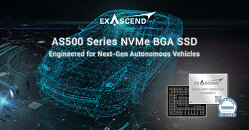- Joined
- Oct 9, 2007
- Messages
- 46,567 (7.66/day)
- Location
- Hyderabad, India
| System Name | RBMK-1000 |
|---|---|
| Processor | AMD Ryzen 7 5700G |
| Motherboard | ASUS ROG Strix B450-E Gaming |
| Cooling | DeepCool Gammax L240 V2 |
| Memory | 2x 8GB G.Skill Sniper X |
| Video Card(s) | Palit GeForce RTX 2080 SUPER GameRock |
| Storage | Western Digital Black NVMe 512GB |
| Display(s) | BenQ 1440p 60 Hz 27-inch |
| Case | Corsair Carbide 100R |
| Audio Device(s) | ASUS SupremeFX S1220A |
| Power Supply | Cooler Master MWE Gold 650W |
| Mouse | ASUS ROG Strix Impact |
| Keyboard | Gamdias Hermes E2 |
| Software | Windows 11 Pro |
Exascend, a service-oriented provider of innovative storage and memory solutions, today unveiled its AS500 series NVMe Ball Grid Array solid state drive (BGA SSD). Engineered to address the demanding data storage requirements of next-generation connected and autonomous vehicles, the AS500 combines exceptional endurance with virtualization capabilities in an ultra-compact BGA form factor.
"The immense data demands of autonomous driving, infotainment systems, digital cockpits and advanced driver assistance systems (ADAS) require ruggedized storage solutions capable of withstanding extreme automotive conditions," said Frank Chen, CEO of Exascend. "The AS500 BGA SSD delivers sustained performance and virtualization support, offering automakers a compact, robust and power-efficient storage solution for in-vehicle deployments. We're particularly proud that the innovative AS500 series recently took home a Best in Show honor at Embedded World 2024."

The soldered AS500 BGA SSD is built to safeguard data integrity in the harshest environments. It operates at temperatures from -40°C to +105°C while withstanding extreme shock and vibration. Exascend's proprietary Adaptive Thermal Control algorithm enables sustained peak performance by effectively regulating temperature within specified thresholds. The AS500 is currently undergoing AEC-Q100 Grade 2 qualification to meet rigorous automotive reliability standards.
The DRAM-less AS500 leverages Host Memory Buffer (HMB) technology to optimize I/O performance without SSD onboard DRAM, mitigating the storage capacity limitations of embedded systems. With an ultra-low active power consumption under 3.5 W, the drive provides significant energy savings.
With built-in SR-IOV support for up to four virtual machines via direct PCIe, the AS500 maximizes performance across multiple in-vehicle application. Its PCIe Gen 4 interface and NVMe 1.4 protocol enable exceptional sequential read/write speeds up to 5000/1600 MB/s and random 4K read/write speeds up to 380K/180K IOPS in HMB mode. Available up to 1 TB capacities, the versatile AS500 is optimized for automotive use cases including in-vehicle infotainment, navigation, digital cockpit, black box and ADAS.
Exascend will showcase the AS500 BGA SSD at the upcoming ADAS & Autonomous Vehicle Technology Expo, June 4-6 in Stuttgart, Germany at booth 6320.
View at TechPowerUp Main Site
"The immense data demands of autonomous driving, infotainment systems, digital cockpits and advanced driver assistance systems (ADAS) require ruggedized storage solutions capable of withstanding extreme automotive conditions," said Frank Chen, CEO of Exascend. "The AS500 BGA SSD delivers sustained performance and virtualization support, offering automakers a compact, robust and power-efficient storage solution for in-vehicle deployments. We're particularly proud that the innovative AS500 series recently took home a Best in Show honor at Embedded World 2024."

The soldered AS500 BGA SSD is built to safeguard data integrity in the harshest environments. It operates at temperatures from -40°C to +105°C while withstanding extreme shock and vibration. Exascend's proprietary Adaptive Thermal Control algorithm enables sustained peak performance by effectively regulating temperature within specified thresholds. The AS500 is currently undergoing AEC-Q100 Grade 2 qualification to meet rigorous automotive reliability standards.
The DRAM-less AS500 leverages Host Memory Buffer (HMB) technology to optimize I/O performance without SSD onboard DRAM, mitigating the storage capacity limitations of embedded systems. With an ultra-low active power consumption under 3.5 W, the drive provides significant energy savings.
With built-in SR-IOV support for up to four virtual machines via direct PCIe, the AS500 maximizes performance across multiple in-vehicle application. Its PCIe Gen 4 interface and NVMe 1.4 protocol enable exceptional sequential read/write speeds up to 5000/1600 MB/s and random 4K read/write speeds up to 380K/180K IOPS in HMB mode. Available up to 1 TB capacities, the versatile AS500 is optimized for automotive use cases including in-vehicle infotainment, navigation, digital cockpit, black box and ADAS.
Exascend will showcase the AS500 BGA SSD at the upcoming ADAS & Autonomous Vehicle Technology Expo, June 4-6 in Stuttgart, Germany at booth 6320.
View at TechPowerUp Main Site



